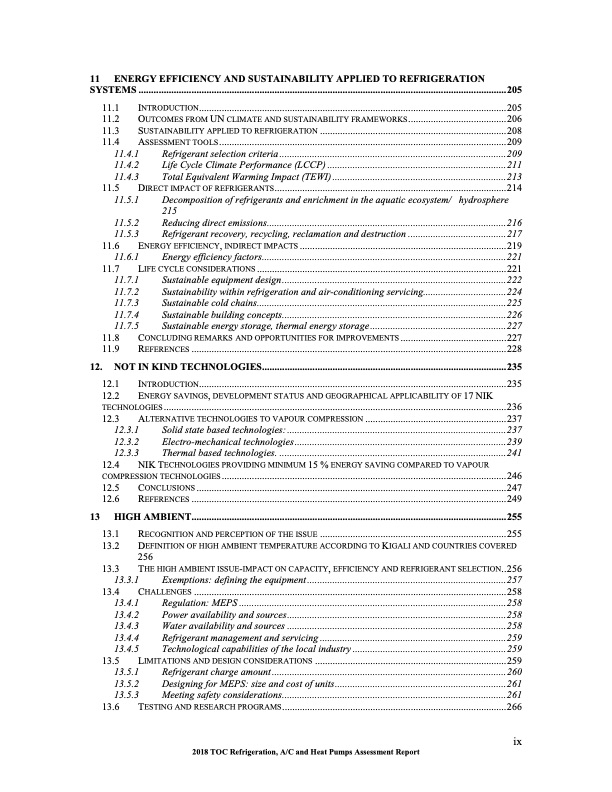
PDF Publication Title:
Text from PDF Page: 010
11 ENERGY EFFICIENCY AND SUSTAINABILITY APPLIED TO REFRIGERATION SYSTEMS ..................................................................................................................................................205 11.1 INTRODUCTION..........................................................................................................................205 11.2 OUTCOMES FROM UN CLIMATE AND SUSTAINABILITY FRAMEWORKS.......................................206 11.3 SUSTAINABILITY APPLIED TO REFRIGERATION ..........................................................................208 11.4 ASSESSMENT TOOLS..................................................................................................................209 11.4.1 Refrigerant selection criteria ..........................................................................................209 11.4.2 Life Cycle Climate Performance (LCCP) .......................................................................211 11.4.3 Total Equivalent Warming Impact (TEWI) .....................................................................213 11.5 DIRECT IMPACT OF REFRIGERANTS............................................................................................214 11.5.1 Decomposition of refrigerants and enrichment in the aquatic ecosystem/ hydrosphere 215 11.5.2 Reducing direct emissions...............................................................................................216 11.5.3 Refrigerant recovery, recycling, reclamation and destruction .......................................217 11.6 ENERGY EFFICIENCY, INDIRECT IMPACTS ..................................................................................219 11.6.1 Energy efficiency factors.................................................................................................221 11.7 LIFE CYCLE CONSIDERATIONS ...................................................................................................221 11.7.1 Sustainable equipment design.........................................................................................222 11.7.2 Sustainability within refrigeration and air-conditioning servicing.................................224 11.7.3 Sustainable cold chains...................................................................................................225 11.7.4 Sustainable building concepts.........................................................................................226 11.7.5 Sustainable energy storage, thermal energy storage ......................................................227 11.8 CONCLUDING REMARKS AND OPPORTUNITIES FOR IMPROVEMENTS ..........................................227 11.9 REFERENCES .............................................................................................................................228 12. NOT IN KIND TECHNOLOGIES.................................................................................................235 13 12.1 INTRODUCTION..........................................................................................................................235 12.2 ENERGY SAVINGS, DEVELOPMENT STATUS AND GEOGRAPHICAL APPLICABILITY OF 17 NIK TECHNOLOGIES ........................................................................................................................................236 12.3 ALTERNATIVE TECHNOLOGIES TO VAPOUR COMPRESSION ........................................................237 12.3.1 Solid state based technologies:.......................................................................................237 12.3.2 Electro-mechanical technologies....................................................................................239 12.3.3 Thermal based technologies. ..........................................................................................241 12.4 NIK TECHNOLOGIES PROVIDING MINIMUM 15 % ENERGY SAVING COMPARED TO VAPOUR COMPRESSION TECHNOLOGIES .................................................................................................................246 12.5 CONCLUSIONS ...........................................................................................................................247 12.6 REFERENCES .............................................................................................................................249 HIGH AMBIENT.............................................................................................................................255 13.1 RECOGNITION AND PERCEPTION OF THE ISSUE ..........................................................................255 13.2 DEFINITION OF HIGH AMBIENT TEMPERATURE ACCORDING TO KIGALI AND COUNTRIES COVERED 256 13.3 THE HIGH AMBIENT ISSUE-IMPACT ON CAPACITY, EFFICIENCY AND REFRIGERANT SELECTION..256 13.3.1 Exemptions: defining the equipment ...............................................................................257 13.4 CHALLENGES ............................................................................................................................258 13.4.1 Regulation: MEPS ..........................................................................................................258 13.4.2 Power availability and sources.......................................................................................258 13.4.3 Water availability and sources .......................................................................................258 13.4.4 Refrigerant management and servicing ..........................................................................259 13.4.5 Technological capabilities of the local industry .............................................................259 13.5 LIMITATIONS AND DESIGN CONSIDERATIONS ............................................................................259 13.5.1 Refrigerant charge amount .............................................................................................260 13.5.2 Designing for MEPS: size and cost of units....................................................................261 13.5.3 Meeting safety considerations.........................................................................................261 13.6 TESTING AND RESEARCH PROGRAMS.........................................................................................266 2018 TOC Refrigeration, A/C and Heat Pumps Assessment Report ixPDF Image | Heat Pumps Technical Options

PDF Search Title:
Heat Pumps Technical OptionsOriginal File Name Searched:
RTOC-assessment-report-2018_0.pdfDIY PDF Search: Google It | Yahoo | Bing
CO2 Organic Rankine Cycle Experimenter Platform The supercritical CO2 phase change system is both a heat pump and organic rankine cycle which can be used for those purposes and as a supercritical extractor for advanced subcritical and supercritical extraction technology. Uses include producing nanoparticles, precious metal CO2 extraction, lithium battery recycling, and other applications... More Info
Heat Pumps CO2 ORC Heat Pump System Platform More Info
| CONTACT TEL: 608-238-6001 Email: greg@infinityturbine.com | RSS | AMP |